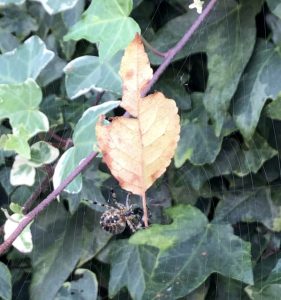How does a spider remove a leaf that’s fallen onto its web?
Spider’s webs are difficult to see which is why they are successful in snaring an unsuspecting flying insect. Webs are made of strong flexible silk which is laced with sticky globules to catch living prey items used as food. After seeing the Red Admiral, Comma and Speckled Wood butterfly all nectaring just a short distance from the large vertical orb web. The owner was a Garden Cross spider, Araneus diadematus. I decided to drop a leaf onto the web for two reasons. One is that I have seen butterflies being eaten by Garden Cross spiders, so hopefully, these butterflies, (which were well within the range of prey items for this spider and its large web), will see the leaf hanging in mid-air and would not end up as food if they flew into the strategically made web. The other was to see what, if anything the spider would do about the leaf as she waited patiently at the centre of her death trap, for her next meal. Well, she did n’t get one from me!

How do spiders remove fallen leaves from their webs?
The size of this web was large. Factors related to the size Garden Cross spider webs are discussed here. Any prey item that collides into the web causes vibration in the web strands as they struggle as they trying to free themselves. The spider picks up the vibration and any movement from its prey. Having very poor eyesight, spiders can sense through the vibrations made by the entrapped prey item, where exactly it is, how heavy it is and roughly how big it is. The web mesh size would also be a size indicator as very small prey may simply fly through the net.
These large female spiders regularly eat their mates before or after mating!
See film of a garden cross ‘spiderling ‘explosion!’
You may find the UK spider site British Arachnological Society (BAS) site interesting
For more information about butterflies see Butterfly Conservation

Recent Comments